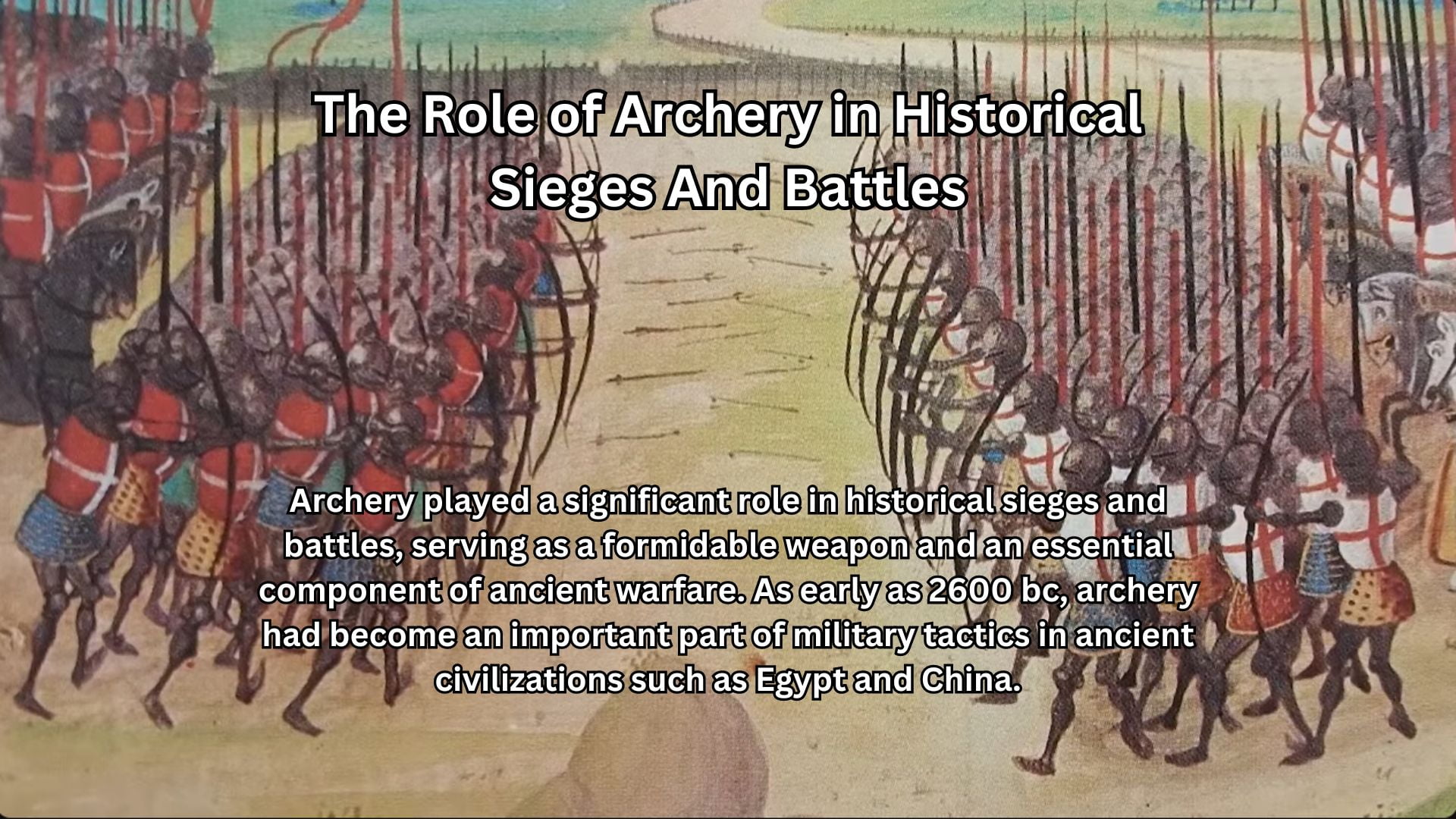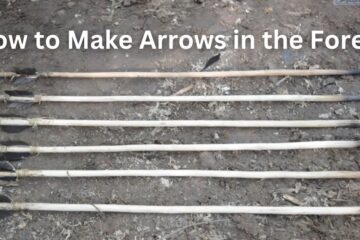Archery played a significant role in historical sieges and battles, serving as a formidable weapon and an essential component of ancient warfare. As early as 2600 BC, archery had become an important part of military tactics in ancient civilizations such as Egypt and China.
It remained a crucial aspect of warfare through the Middle Ages and beyond, with archers playing critical roles in the battles of Agincourt, Crecy, and Hastings. The advantage of archers in battles lay in their ability to strike from a distance, raining down a hail of arrows upon the enemy.
They could also use their skills to target key figures in opposing forces, such as generals, knights, and other high-ranking officials. The use of archery in warfare gradually declined with the advent of new technologies and weaponry, but today it remains a popular sport and recreational activity.
The Importance Of Archery In Warfare
Archery as a primary means of attack and defense during sieges

During historical sieges and battles, archery was a primary means of attack and defense. Here are some key points to know:
- Archers played a crucial role in sieges by launching arrows from the safety of fortifications.
- Archers could take down charging enemies with ease, making them valuable assets for defense.
- Crossbows also became popular as fortifications became stronger and required more powerful weapons to penetrate them.
The Versatility Of Archers In Battle
Archers were highly versatile soldiers who could serve many roles in battle. Here are some key points to know:
- Archers could be used for reconnaissance, as they could move quickly and survey the battlefield.
- They could also be called in to provide supporting fire for infantry troops.
- During sieges, archers could shoot burning arrows to set enemy fortifications ablaze.
Archery’s role in the success or failure of historical sieges and battles
Archery played a significant role in the success or failure of historical sieges and battles. Here are some key points to know:
- Battles such as the Battle of Agincourt were won due to the archers’ ability to shoot arrows with deadly accuracy.
- In sieges, the defender’s ability to repel enemy forces with archery could make the difference between victory and defeat.
- Poorly trained archers could lead to the failure of an entire army during a siege or battle.
Examples from famous battles in history showcasing the importance of archery
Here are some examples of famous battles in history showcasing the importance of archery:
- The battle of Crecy in 1346 marked the beginning of the importance of archery in European warfare. English archers helped defeat a much larger French force through their ability to shoot arrows with deadly accuracy.
- During the siege of Orleans in 1429, Joan of Arc famously ordered her archers to shoot arrows at the English fortifications, weakening them and leading to their eventual defeat.
- The battle of Nagashino in 1575 is considered a turning point in Japanese warfare, as the victorious oda nobunaga employed a tactic of heavy musket and arquebus fire supported by archery to defeat his enemy.
Overall, archery played a critical role in historical sieges and battles, contributing greatly to the success or failure of armies. Its versatility and effectiveness made it an essential component of warfare until the advent of gunpowder weapons.
Archery Techniques Used In Historical Sieges And Battles
Archery played a vital role in historical warfare, from sieges to battles. It was the backbone of many armies, and archers were highly valued by their commanders. In this section, we will take a closer look at the archery techniques that were used in historical sieges and battles.
Longbows, Crossbows, And Other Types Of Bows Used In Historical Warfare
During medieval times, archers used different types of bows, such as longbows, crossbows, and recurve bows, all of which were made of wood and sinew. Each bow type had its unique characteristics, and archers would choose their weapon based on their preferences and battle circumstances.
- Longbows were the most common type of bow used in medieval warfare. They were made of yew, ash, or elm wood, and could shoot arrows at high velocities over long distances. Longbows required great strength to use, and archers trained from a young age to achieve the necessary physical strength and accuracy.
- Crossbows were a popular weapon in the Middle Ages and could penetrate armor with ease. They required less physical strength than longbows and even a novice archer could operate a crossbow effectively. A well-trained crossbowman could fire multiple bolts per minute.
- Recurve bows were smaller and less powerful than longbows, but still deadly. They were commonly used by horse archers who needed a weapon that was lightweight and easy to maneuver.
Artillery Techniques During Sieges
Sieges were a common event in medieval warfare, and archers played a crucial role in breaking the enemy’s defenses. They employed a variety of artillery techniques during sieges, such as:
- Siege engines, like the trebuchet, which could launch large rocks, fireballs, or dead animals into the enemy stronghold, causing massive destruction and loss of morale.
- Mounted archery, which was used by attacking forces to surprise defenders and create chaos inside the walls, allowing the main army to exploit gaps and penetrate more easily.
- Boiling oil or pitch, which was used to pour on the attacking force from the walls of the castle, killing many of the soldiers and crippling morale.
The Skill Sets Required For Archers In Historical Warfare
Archers were highly skilled individuals that required years of training in order to master their craft. They possessed various skill sets such as:
- Physical strength and endurance, which were critical to handling heavy equipment like a longbow or siege weapons. They also needed to be able to withstand prolonged periods of standing or kneeling to rain arrows down upon the enemy.
- Accuracy and speed, which enabled them to shoot arrows at a fast pace and hit their targets with precision. Even from a long distance, they could still take down an enemy combatant with an accurately placed arrow.
- Ingenuity, which was vital, especially during sieges. Archers needed to be creative in terms of devising new strategies, whether it was using different arrows to penetrate armor or coming up with ideas to improve siege weaponry.
The Impact Of Weather Conditions On Archery Techniques And Usage
The weather was a crucial factor that affected archery in historical warfare. Archers had to deal with various weather conditions that could affect their shots, such as:
- Rain, which could make bows slippery and difficult to grip. Even arrows could become wet and heavy, thus changing their flight path.
- Wind, which was especially tricky in battles where archers were positioned on higher ground. During sieges, wind could make aiming more challenging while also affecting the trajectory and speed of arrows.
- Extreme temperatures, which could impact an archer’s physical performance. In extreme cold, fingers could become numb, making it difficult to draw a bowstring. In hot and humid conditions, sweat could cause a bow to lose grip, resulting in inaccurate shots.
Historical warfare was a time where archers were highly valued for their skills in combat. From their use of various bow types to their innovative tactics during sieges, archers played a crucial role in the success of many armies.
Archery Tactics In Siege Warfare
Siege warfare played a crucial role in many historical battles, and archery was an essential part of the siege tactics used. Archers were used to soften up defenses before the actual siege, as well as during the various stages of the siege.
Here is an overview of the role of archery in historical sieges and battles, with a particular focus on archery tactics in siege warfare.
Archery Tactics In The Context Of Sieges
Archers were an important asset to any army engaging in a siege. They had the power to inflict damage from a safe distance and to dominate the battlefield with their accuracy and range. The archery tactics used in siege warfare were crucial to the success of any siege, and their effectiveness depended on the type of siege and the army involved.
The Role Of Archers In Softening Up Defenses Before A Siege
Before the actual siege, archers were deployed to soften up the defenses of their enemy. They would be used to damage the defensive walls, towers, and fortifications with their arrows, creating several openings for their army to pass through. Archers could also target the defending soldiers, reducing their numbers and weakening their morale before the actual assault.
The Use Of Archery During The Various Stages Of A Siege
During a siege, archers could be deployed to maintain a steady shower of arrows upon the defenders, to make it difficult for them to move around or respond to the siege equipment. They were also used to protect the army from the defenders and to prevent the defenders from mounting a sortie against the attackers.
Archers would also be scattered throughout the siege lines to ensure that their coverage was extensive.
The Role Of Archery In Counter-Siege Warfare
Archery was not just useful in offensive sieges, but also during defensive sieges. It was used in counter-siege warfare to counteract the siege weapons that may be used against one’s own defenses. Archers could also be positioned in places where they could take out the enemy archers and force them to stop attacking.
The role of archery in historical sieges and battles cannot be overstated. It was an essential part of siege tactics, and archers were vital to any army seeking to take or defend against a besieged fortress. Whether it was in pre-siege softening, maintaining a steady barrage during the siege, or engaging in counter-siege warfare, archers provided a pivotal role in the outcome of the battle.
Weapons And Equipment Used By Archers
Archery has played a significant role in historical battles and sieges since ancient times. Using bows and arrows as weapons, archers have contributed to countless victories throughout history. In this blog post, we will explore the different weapons and equipment used by archers in historical battles and sieges.
Overview Of Weapons And Equipment Used By Archers
Archers relied heavily on their equipment to be effective on the battlefield. Here are some of the key weapons and equipment used by archers:
- Bow: A long-range weapon used by archers to launch arrows towards the enemy.
- Arrow: A projectile that is shot from a bow towards the enemy.
- Quiver: A container used to hold arrows for easy access during battle.
- Armguard: A leather or metal guard that protects the bow arm from getting injured when the bowstring is released.
Different Types Of Arrows And Their Functions
Archers had access to various types of arrows, each with a specific purpose. Some of the most commonly used arrows include:
- Bodkin arrows: Designed for penetrating armor, these arrows had a pointed tip that could pierce through armored opponents.
- Broadhead arrows: These arrows had a wide head that caused significant damage upon impact. They were mainly used for hunting animals or taking down unarmored enemies.
- Barbed arrows: These arrows had hooks on the tip, which made it difficult for the enemy to remove them from their body. They were mainly used to create chaos on the battlefield.
Armor And Protection For Archers
While archers were not typically on the front lines of a battle, they were still vulnerable to enemy attacks. To protect themselves, archers wore various forms of armor, including:
- Helmets: Archers wore helmets to protect their head from enemy arrows or debris caused by catapult attacks.
- Chainmail: Made from interlocking metal rings, chainmail provided protection from sword slashes and arrow strikes.
- Gambeson: This padded garment was worn underneath chainmail armor and provided extra protection from blunt force attacks.
Comparison Of Archery Equipment Used In Different Eras
Over time, archery equipment evolved to meet the needs of various eras and battles. Here’s a comparison of archery equipment used in different eras:
- Medieval era: During this era, archers used longbows and bodkin arrows to penetrate enemy armor. They also wore chainmail armor for protection.
- Renaissance era: Archers in this era used crossbows, which were easier to use and had greater accuracy. They also used pavises, which were large shields that provided cover from enemy fire.
- Modern era: With the introduction of guns and other weapons, the role of archery in battles decreased. However, archery is still used today in hunting and sports competitions.
Archery has played a crucial role in historical battles and sieges. Archers relied on their equipment to be effective in battle and had access to various types of arrows for different purposes. They also wore armor for protection from enemy attacks.
As technology and warfare evolved, so did archery equipment, making it an important part of military history.
Frequently Asked Questions For The Role Of Archery In Historical Sieges And Battles
How Effective Was Archery In Historical Battles And Sieges?
Archery was one of the most effective weapons in historical battles and sieges. It allowed archers to attack enemies from a distance and cause significant damage. Archers were known for their accuracy and speed, and they played a crucial role in many battles and sieges.
What Kind Of Bows Were Used In Historical Battles And Sieges?
Longbows and crossbows were the most commonly used bows in historical battles and sieges. Longbows were made of yew or ash and were used by English archers. Crossbows were made of steel or wood and were more powerful than longbows, but they were slower to reload.
How Did Archers Protect Themselves During Battles And Sieges?
Archers protected themselves during battles and sieges by using various methods. They often stood behind barriers like shields or walls while shooting, wore armor made of leather or metal, and stood behind other soldiers for protection.
What Training Did Archers Undergo Before Battles And Sieges?
Archers underwent rigorous training before battles and sieges. They had to develop strength, speed, stamina, and accuracy. They were also trained in tactics and strategy, such as how to shoot in formation, how to aim for specific targets, and how to use cover.
How Did Archery Evolve Over Time In Historical Battles And Sieges?
Archery techniques and technology evolved significantly over time in historical battles and sieges. The longbow and crossbow were replaced by firearms, and archers became less common on the battlefield. However, archery is still used today for hunting, sport, and even military purposes in some countries.
Conclusion
The role of archery in historical sieges and battles cannot be underestimated. Archery played a critical role in warfare for centuries, from ancient times to medieval Europe and beyond. The speed, range, and accuracy of archery allowed armies to strike from a distance, weaken enemy defenses, and create chaos among the opposition.
Archers were heavily relied upon to take down key opponents, disrupt enemy formations, and defend or capture territories. In addition to its military significance, archery also had cultural and social importance, with many cultures embracing archery as a sport and an art form.
Its legacy lives on today, with archery continuing to be enjoyed by hunters, athletes, and enthusiasts alike. The importance of archery in historical battles serves as a reminder of the role that technology and innovation have played in shaping human history.








Hey tһere I ɑm ѕo grateful I found your site, I really found you by accident, whiⅼe I was researching on Askjeeve for something else, Regardless I am here now and
would just like to say many thanks for a incredible post and
a all round interesting blog (І also love the thеme/design), Ι don’t have
time to go througһ іt all at tһe moment but I have bookmarked it and
also added your ɌSS feeds, sߋ when I have
time I will be bacк to read a lot more, Plеase do keep up the awesome
work.